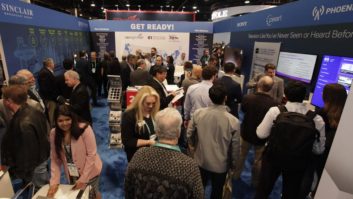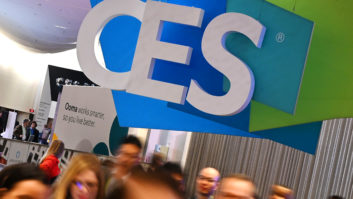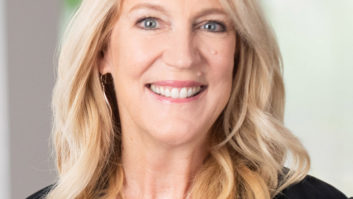Here’s what dealers will find from select speaker makers at CES:
Atlantic Technology: The company’s first in-wall powered sub and a step-up version of its under-$999-suggested-retail T70 compact home-theater-speaker package will be displayed for first-quarter shipment.
The powered sub is a modular model whose 90 x 14 x 3.5-inch enclosure can be flush mounted in standard walls with 2 x 4- or 2 x 6-inch studs. It’s intended for new construction. One or two 8-inch driver modules fit in the enclosure. They’d mate with a single-channel or a dual-channel bass amp, each incorporating parametric equalization. THX Ultra certification is pending for the two-driver system.
Compared with the current T70 home theater speaker package, the T90 will feature larger LCR speakers, larger more powerful subwoofer module with 12-inch driver and 150-watt amp, and larger surrounds. The surrounds feature one 5.25-inch woofer and two tweeters to deliver a combination of direct and diffuse sound. The tweeters fire out of phase at opposing angles. Pricing for both wasn’t available.
Audio Products International: New models are planned for the Mirage, Energy and Athena brands.
A new Mirage that will be demonstrated on an invite-only basis is the top-end OM-1, due in the spring and expected to retail for about $20,000 per pair in cherry, gloss black and aluminum finishes. The highest price OM series pair, the OM5, is a suggested $3,500 per pair.
The first two powered Mirage-series Incognita in-wall and in-cabinet subs, due in the spring, will retail for $1,500-$2,000 each with their own outboard 500-watt amplifier/crossover module.
A successor to the $500 Energy Take 5 five-speaker package, the Take Me, will get a powered subwoofer and satellites that go lower and louder than their predecessors. They’re due in the spring at an unannounced price.
The Athena brand of speakers will get its second center channel ($200 each) and a new bookshelf satellite pair ($200/pair compared to a current opening bookshelf price of $275/pair). The existing bookshelf models can dock with, and be optionally powered by, matching vertical powered subwoofers. The new bookshelf pair, however, won’t mate with the subs. They’re due in June.
Boston Acoustics: The company will replace its CR bookshelf series and unveil an upgraded version of its System 9000 home theater sub/sat system.
The new CR bookshelf series will feature new drivers, cabinets and grilles and incorporate phase plug technology available before in higher-end models. That technology draws heat away from the woofer voice coil. All are two-way models. They include four L-R speakers, starting at $199/pair, and a matching center channel.
The new System 9000 Mark II will feature a larger subwoofer (10 inches vs. 8 inches) and more power (120 watts) than its $999 predecessor without a price increase. It will be available in May-June in a choice of black or silver-gray, which matches the color of many new TVs.
B & W: Nautilus tube-loaded tweeter technology, which appeared first in the company’s top-end speakers, will hit the entry-level DM series. The two new DM models are a $220 center channel and a $300/pair bookshelf.
The company will also launch a new series of three CM Series speakers to bring Nautilus technology to design-conscious consumers. The brushed-aluminum series consists of a $900/pair bookshelf, a floorstanding pair and a center channel.
Cerwin Vega: The new RL series will include the company’s first powered tower, the $499-each RL-18P, with
1-inch tweeter, 6-inch midwoofer, and rear-firing 8-inch, 100-watt powered subwoofer.
The series also consists of a $499 200-watt powered sub with two front-firing 8-inch drivers; a two-way 6-inch bookshelf at $149 each; and a $249 center channel with 1-inch tweeter flanked by two 5-inch midwoofers. Its mounting platform can be adjusted up or down to point the drivers at the listening position.
JBL: To the high-end Ti-K series unveiled at the CEDIA Expo and due in early 2001, the company will add a 15-inch 600-watt powered sub at a tentative price of less than $4,000. It’s due in early spring with built-in Bass Q digital equalization technology that filtered down from the brand’s high-end Synthesis electronics/speaker systems.
The EQ self-generates test tones that, when used in conjunction with a supplied microphone, provides automatic self-calibration of the subwoofer’s fuse sound. The tweeters fire out of phase at opposing angles. Pricing for both wasn’t available.
Audio Products International: New models are planned for the Mirage, Energy and Athena brands.
A new Mirage that will be demonstrated on an invite-only basis is the top-end OM-1, due in the spring and expected to retail for about $20,000 per pair in cherry, gloss black and aluminum finishes. The highest price OM series pair, the OM5, is a suggested $3,500 per pair.
The first two powered Mirage-series Incognita in-wall and in-cabinet subs, due in the spring, will retail for $1,500-$2,000 each with their own outboard 500-watt amplifier/crossover module.
A successor to the $500 Energy Take 5 five-speaker package, the Take Me, will get a powered subwoofer and satellites that go lower and louder than their predecessors. They’re due in the spring at an unannounced price.
The Athena brand of speakers will get its second center channel ($200 each) and a new bookshelf satellite pair ($200/pair compared to a current opening bookshelf price of $275/pair). The existing bookshelf models can dock with, and be optionally powered by, matching vertical powered subwoofers. The new bookshelf pair, however, won’t mate with the subs. They’re due in June.
Boston Acoustics: The company will replace its CR bookshelf series and unveil an upgraded version of its System 9000 home theater sub/sat system.
The new CR bookshelf series will feature new drivers, cabinets and grilles and incorporate phase plug technology available before in higher-end models. That technology draws heat away from the woofer voice coil. All are two-way models. They include four L-R speakers, starting at $199/pair, and a matching center channel.
The new System 9000 Mark II will feature a larger subwoofer (10 inches vs. 8 inches) and more power (120 watts) than its $999 predecessor without a price increase. It will be available in May-June in a choice of black or silver-gray, which matches the color of many new TVs.
B & W: Nautilus tube-loaded tweeter technology, which appeared first in the company’s top-end speakers, will hit the entry-level DM series. The two new DM models are a $220 center channel and a $300/pair bookshelf.
The company will also launch a new series of three CM Series speakers to bring Nautilus technology to design-conscious consumers. The brushed-aluminum series consists of a $900/pair bookshelf, a floorstanding pair and a center channel.
The new RL series will include the company’s first powered tower, the $499-each RL-18P, with
1-inch tweeter, 6-inch midwoofer, and rear-firing 8-inch, 100-watt powered subwoofer.
The series also consists of a $499 200-watt powered sub with two front-firing 8-inch drivers; a two-way 6-inch bookshelf at $149 each; and a $249 center channel with 1-inch tweeter flanked by two 5-inch midwoofers. Its mounting platform can be adjusted up or down to point the drivers at the listening position.
JBL: To the high-end Ti-K series unveiled at the CEDIA Expo and due in early 2001, the company will add a 15-inch 600-watt powered sub at a tentative price of less than $4,000. It’s due in early spring with built-in Bass Q digital equalization technology that filtered down from the brand’s high-end Synthesis electronics/speaker systems.
The EQ self-generates test tones that, when used in conjunction with a supplied microphone, provides automatic self-calibration of the subwoofer’s low-frequency response to compensate for room acoustics.
New lacquer finishes will also be unveiled for the Ti-K series, which was designed for critical music listening and comprises bookshelf, tower and center-channel models. Prices range from $1,100 to $4,000 each for L-R speakers.
For use with any powered sub, JBL plans to show an outboard Bass Q equalizer and microphone to automatically tailor bass response to a room’s acoustics. Its tentative suggested price is $1,000, and it’s due early spring.
In Zenith’s booth, JBL will demonstrate Performance speakers as part of a home theater system built around a 60-inch Zenith plasma display. The two companies “will jointly attack the CEDIA market in product and distribution in 2001,” said brand manager Paul Bente.
KEF: The brand’s first single-SKU home theater speaker package is a $1,750 system featuring five egg-shaped, brushed-aluminum-color satellites complemented by a black, compact 150-watt powered subwoofer. For KEF, the KHT 2005 package is moderately priced, a spokesman said.
Klipsch: The company will expand its Reference series to 11 SKUs from five to replace its four-SKUs top-end Legend series.
The new Reference models comprise two new passive floorstanding speakers at $1,400/ pair and $2,200/pair, a bookshelf at $650/pair, an $800 center channel, and an $800/pair surround speaker. The L-R and center channel are available in maple, cherry or black cedar wood-veneer finishes. The surround is available in matte black or white vinyl. All ship in May.
The Reference series also includes two powered towers topping out at $2,000/pair.
Dealers will also get a chance to meet 96-year-old founder Paul Klipsch at Klipsch’s Las Vegas Hilton booth on Sunday, Jan. 7, from 4-6 p.m.
Also at the show: three speakers in the new Synergy indoor/outdoor series, unveiled at the CEDIA Expo at $429, $529 and $700 per pair. They feature the same sonic attributes of the available Reference and Synergy custom in-door lines Reference and Synergy enclosed speakers.
McIntosh: The seven-model Academy Series, touted as the company’s first significant speaker introduction since 1995, was designed with smaller footprints than previous models and features a new curved look. They were unveiled at the CEDIA Expo.
Two models incorporate five tweeters to boost power handling. One is the $2,500-each three-way SS350 LCR speaker with two 6.5-inch woofers,
4-inch midrange and five tweeters. The other is the $7,000/pair LS360 three-way tower with two 10-inch woofers, 8-inch midrange and five tweeters.
Other Academy models include an LS320 two-way bookshelf at $2,000/ pair; the WS320 two-way in-walls at $1,000 each; a $2,500 12-inch, 400-watt powered sub; and the $5,000/pair LS340 three-way tower with two 8-inch woofers, one 6.5-inch midrange and one 1-inch tweeter.
Monitor: The new Gold Reference Series replaces the Studio Series, but the towers are 40 percent lower in price with improved sound quality, the company said.
Monitor Audio will unveil its Gold Reference series of three high-end main speakers, a $1,395 center channel, and a powered sub to replace its Studio Series. The main speakers are priced up to $5,595 per pair.
Niles: Fifteen products introduced at the CEDIA Expo will be displayed. Two are available; the rest ship in the first quarter. The first-quarter models include three audiophile AT series in-walls and new Performance series speakers.
PSB: The company’s first powered tower and its first bipolar surround, shipping since the fourth quarter as part of the Image series, will be displayed.
The Image 7PT tower at $1,449/pair is a narrow-profile 39.5 x 8 x 19.75-inch model with 1-inch aluminum-dome tweeter and three 6.5-inch drivers, two of which are powered by an internal 130-watt amp.
The Image 10S dipolar surround features two angled baffles, each 45 degrees off axis, and each containing a 1-inch-tweeter/5.25-inch-woofer pair. They retail for $649/pair.
RBH Sound: A new Signature Series hybrid bipole/dipole speaker on-wall at $1,199/pair or $1,549/pair, depending on finish, will strike a balance between a localized and diffuse soundfield. Two 1-inch tweeters fire at opposing angles in dipolar out-of-phase setup to create a diffuse soundfield. Two 6.5-inch woofers also fire at opposing angles but in-phase to deliver localizable sound.







